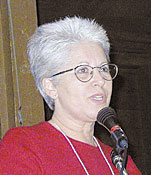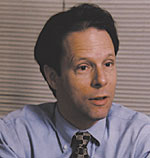|
Sierra Club, organized labor agree and argue as potential alliance struggles to be born
By John Byrne Barry
Relationships, Not Magic | Making the Connection | Ten Ways Sprawl Harms Unions
 Several newspaper stories characterized the recent victory over Arctic drilling as the Sierra Club and environmentalists prevailing over the Teamsters and other blue-collar workers. But that wasn't the real story. The oft-repeated saw that environmentalists and workers are in opposing camps is becoming increasingly outdated. Several newspaper stories characterized the recent victory over Arctic drilling as the Sierra Club and environmentalists prevailing over the Teamsters and other blue-collar workers. But that wasn't the real story. The oft-repeated saw that environmentalists and workers are in opposing camps is becoming increasingly outdated.
In fact, dozens of unions signed on to a letter supporting Arctic protection, both national organizations, like the Service Employees International Union, as well as locals or dissidents that took a different stand than their national counterparts, like the Teamsters for a Democratic Union. Despite some high-profile disagreements, the Sierra Club's relationships with organized labor are showing increasing promise.
In December, the AFL-CIO passed a resolution in favor of "smart growth," which Sierra Club activists are advocating in almost every chapter. In February, the SEIU, the Union of Needletrades, Industrial and Textile Employees and District 11 of the Steelworkers joined environmentalists in a new blue-green alliance to fight global warming and create new jobs. This is promising, but largely unexplored territory, fraught with obstacles.
As Sierra Club Executive Director Carl Pope says, "No one has done what we are trying to do."
Les Reid, former union steward, former member of the Sierra Club's board of directors and, until recently, chair of the Club's Workplace Environment Committee, blazed the trail three decades ago, pushing to get the Club involved in issues like workplace safety. In 1973, the Sierra Club supported the Oil, Chemical and Atomic Workers strikes against Shell over health and environmental issues.
But it wasn't until the early 1990s, when the Club and labor joined forces to fight the North American Free Trade Agreement, that the alliance settled in. The World Trade Organization protests in Seattle in 1999 showed how powerful a labor/environmental alliance could be, with tens of thousands of protesters in the streets, chanting the now-legendary mantra "Turtles Love Teamsters. Teamsters Love Turtles."
In the wake of Seattle, AFL-CIO president John Sweeney declared his intention to build on the trade alliance with environmentalists. He first met with the Sierra Club board of directors in March 2000, and working groups were established to find more common ground.
Those meetings are starting to bear fruit.
 "Five years ago, Jane Perkins called me and asked if we could talk about global warming and jobs," says Dan Becker, director of the Sierra Club's Global Warming and Energy Campaign. "We met in her kitchen and set out to come up with a worker-friendly plan to curb global warming." Perkins was environmental liaison for the AFL-CIO at the time. "Five years ago, Jane Perkins called me and asked if we could talk about global warming and jobs," says Dan Becker, director of the Sierra Club's Global Warming and Energy Campaign. "We met in her kitchen and set out to come up with a worker-friendly plan to curb global warming." Perkins was environmental liaison for the AFL-CIO at the time.
It took five years to reach a two-page agreement.
"Early on," says Becker, "we met with a group of unions where someone called us 'filthy lying scum' for a position we had taken a decade earlier. I had forgotten. They hadn't."
But eventually an alliance coalesced. In February 2002, the Blue-Green Alliance, representing more than 3 million workers and environmentalists (including the Union of Concerned Scientists, Natural Resources Defense Council and Sierra Club) released a joint statement in support of the plan originally sketched out in Perkins's kitchen.
"We don't need to choose between blue skies and blue collars," said Pope at the press conference. "We can have both and it is about time that we did."
SEIU President Andrew Stern declared that, "There are solutions that can protect the environment and the livelihoods of working people."
The alliance's plan, "A Worker-Friendly Approach to Combatting Global Warming," would reduce carbon dioxide emissions by 27 percent below projected levels and increase jobs by 660,000 above projected levels by 2010. By 2020, the plan would save more oil than the United States currently imports from OPEC.
These advances, based on a study by the Economic Policy Center and the Center for Sustainable Economy, would be funded by a polluter-pays carbon tax of $50 per ton of emissions, phased in over six years.
Becker says he long believed that promoting efficiency and renewables was a "win-win" scenario because more new jobs would be created than lost. "But it's not a winner for everyone," he says, "If we burn less coal to produce electricity, some coal miners could lose their jobs. This plan can't protect everyone's jobs, but it can protect their livelihoods."
The plan's "Just Transitions" provisions would provide full income replacement for up to five years for displaced workers.
 "Smart Growth. It's a union thing." So says Greg Leroy, longtime union leader, founder of Good Jobs First and new member of the Sierra Club Challenge to Sprawl Campaign. "Smart Growth. It's a union thing." So says Greg Leroy, longtime union leader, founder of Good Jobs First and new member of the Sierra Club Challenge to Sprawl Campaign.
The AFL-CIO's December resolution condemning urban sprawl didn't come as a surprise to LeRoy, but it did to many labor and environmental leaders. After all, don't the carpenters and bricklayers and roofers make a living building all those sprawling subdivisions and highways? Not necessarily, says Don Turner, president of the Chicago Federation of Labor and author of the pro-smart-growth resolution. "Labor is essentially an urban institution," he says. "Its strongest memberships are in cities and older suburbs. If cities wither, if urban neighborhoods are abandoned, labor suffers."
"There are surprisingly few union jobs associated with sprawl," says Tim Frank, chair of the Sierra Club's sprawl campaign. "Wal-Mart, for example, is not only not built or staffed by union labor, it's aggressively hostile to unions."
Still, the building trades have historically opposed smart growth. "To be blunt, many members of the trades suspect that smart growth is 'no growth' in sheep's clothing," says Leroy.
That's changing, slowly. In the San Francisco Bay Area, the building trades and the Sierra Club worked together on several electoral campaigns in Contra Costa County, including open space and urban-growth boundary ballot initiatives.
Frank says redirecting more public investment back into America's urban spaces will help raise union membership and the average wages across a whole range of industries. "We will fight to make sure good jobs are an explicit part of the smart-growth agenda," he says.
The Sierra Club has been collaborating with the building trades unions in California for a couple of decades. When California had its energy crisis in 2001, the Club pushed for cleaner and more efficient power-plants, and reached out to the building trades and consumer advocates. "Every new power plant under construction now in California," says Frank, "is being built with state of the art environmental controls and under a project labor agreement."
PLAs, says Frank, "promote work force development (more minorities and women), save taxpayer dollars and help preserve skills critical to higher density construction."
Last fall, President Bush issued an executive order which would have banned the use of federal funds on any project covered by a PLA. The Building Trades Union sued and won. The Sierra Club filed an amicus brief in support of the suit.
This support, the first collaboration with the building trades at the national level in years, opened doors. "Shortly after we filed our brief," says Frank, "I flew to Washington to meet with the two leaders of the building trades. I told them we have a common interest - building a better America with union labor. It was a new experience for them to have an environmentalist sit down in their office."
Despite the ongoing relationship on trade pacts and the promise on global warming and smart growth, all is far from rosy.
The Teamsters and Building Trades joined with the oil industry to back drilling in the Arctic. The UAW joined the automakers to beat back a boost in auto fuel efficiency.
But those setbacks have not stopped the labor and environmental movements from finding opportunities for collaboration. Earlier this year, there were five joint union-environmentalist trainings on climate change and jobs in California, Oregon, Montana and New Jersey. Next up, Cleveland, Minneapolis and Milwaukee.
"If we can truly unite blue and green at the national level and the grassroots, we can be extremely powerful," says Becker. "But it's hard."
Perkins adds: "Don't underestimate there are people who don't want this alliance to happen."
For information about the AFL-CIO's smart-growth resolution and "Talking to Union Leaders About Smart Growth," see www.goodjobsfirst.org/gjf.htm. See also the Sierra magazine story on Just Transitions: www.sierraclub.org/sierra/199901/unions.asp.
Relationships, Not Magic
Local connections key to effective partnerships.
In the past year, Colorado's Sangre de Cristo Group has held its executive meetings at the Plumbers and Steamfitters Local 20 union hall in Pueblo. That's not the reason that the Sierra Club and organized labor have a good working relationship in Pueblo; it's just one of the many ways they regularly rub elbows.
Fourteen years ago, when Club volunteer Ross Vincent started the successful fight against the Army's plan to incinerate chemical weapons at the Pueblo Depot, he sought help from other organizations in town. Eventually, they joined together as "Better Pueblo," a coalition that includes local labor unions, the Catholic diocese, ranchers and farmers. (For the story, see May Planet, www.sierraclub.org/planet/200204/victory.asp.)
With the incinerator victory behind them, the coalition is grappling with issues like air pollution from a nearby steel mill and a proposed limestone strip mine and concrete plant to be run by Grupo Cementos de Chihuahua, one of Mexico's largest cement companies.
The Steelworkers, locked out by the mill, were looking for ways to increase pressure on the company. The Sierra Club and other plaintiffs joined them to challenge the mill's efforts to weaken its pollution permit. But not all members of the coalition agree about the concrete plant. The Sierra Club opposes it. Some of the unions support it, albeit tepidly.
"We can survive disagreement," says Vincent. "What makes our group durable is that once people sat down and talked to each other, showed they were willing to listen and be respectful, we found out we liked each other. These folks are fun to work with. It's not magic, it's personal relationships."
Developing personal relationships, of course, is just a first step - one that more and more Sierra Club groups and chapters are taking, many for the first time.
National agreements like the Blue-Green Alliance are important, but don't amount to much more than pieces of paper unless they are acted out on the ground.
Phila Back, chair of the Berks Group in Pennsylvania, knocked on doors and chased down friends of friends to get eight local labor leaders to sign a letter opposing drilling in the Arctic. Nebraska energy organizer Melissa Gardner called up the head of the Omaha Federation of Labor (AFL-CIO) to talk about clean energy and jobs and now writes a monthly column in the Omaha Labor Chronicle. In Michigan, Mike Keeler, chapter co-chair, was recently elected as recording secretary of UAW Local 599.
It's not always smooth sailing.
Marti Sinclair, volunteer in the Miami Group (Cincinnati), worked for several years with the Farm Labor Organizing Committee in Ohio to help farmworkers who picked cucumbers improve their working conditions.
Miami Group members went to rallies, paid for several issues of a special newsletter, ran stories in their group and chapter publications. Club activists in several states were involved, and the Sierra Club national board of directors endorsed the FLOC boycott against the North Carolina-based Mt. Olive Pickle Company.
"My daughters and I marched in the 4th of July parade dressed as pickles, chanting, 'Don't give a nickle for a Mt. Olive pickle,'" says Sinclair. "It was a high point of my activist career, but we were baking inside the huge green bags and green balloons."
But strategic differences became an obstacle. FLOC used civil disobedience, a tactic the Sierra Club doesn't engage in. And Mt. Olive and the growers didn't budge from their positions. Both claimed they had no responsibility for the farm workers. The alliance fizzled two years ago.
"Activists work best when they're grounded, when they're in close contact with the communities they're trying to help," says Sinclair. "With the Mt. Olive struggle, we didn't have much contact with the farmworkers. I felt more like an air fern than a grassroots organizer."
Sinclair and the Miami Group now work behind the scenes with local labor groups, going door-to-door. "When the Sierra Club filed a suit that affected the unions, I picked up the phone and called my local contact, so they wouldn't be blindsided. We don't have to agree about everything, but we need to build trust."
Trust is at the heart of the union-Sierra Club alliance in California's Contra Costa County.
The San Francisco Bay Chapter has been working alongside unions since the 1970s, addressing industrial safety and toxic emissions at refineries.
 "Plant employees fully understand that strong environmental standards are necessary to protect them and their families from dangerous toxins," says Chapter Director Michael Bornstein. "Plant employees fully understand that strong environmental standards are necessary to protect them and their families from dangerous toxins," says Chapter Director Michael Bornstein.
The chapter and local unions are also fighting sprawl together. They stopped a development in Franklin Canyon, new subdivisions in Antioch and ran a joint independent expenditure campaign to elect a pro-smart-growth slate to the San Ramon City Council.
"The building trades started questioning sprawl construction because they weren't building union," says Mike Daley, Bay Chapter organizer. But union members concerns extend beyond jobs. "They're stuck in the same traffic, have the same concerns about growth eroding their quality of life."
Although the chapter and local labor leaders don't agree on everything, particularly big construction projects, Bornstein stresses looking for construction projects that are environmentally friendly, like high-speed rail. "It's the most energy efficient form of transportation," he says, "and there are good jobs building it as well as ongoing jobs for train operators."
Editor's note: The above stories are just several of many Club alliances with organized labor. We're only starting to chronicle them. If your chapter or group is working with unions, let us know. We hope to share more collaboration stories in The Planet and/or on our Web site. Contact john.barry@sierraclub.org.
Making the Connection
Developing relationships with unions can be tricky. Who do you talk to? Their organizational structures, with local, regional and national counterparts, can be as unwieldy as the Sierra Club's. Some unions, like the teamsters and SEIU, are decentralized, with most union dues staying at the local level and the locals exercising the most influence. Others have more power concentrated at the national and international levels. Which unions represents which workers varies. In Michigan, the nurses are part of the UAW. In Minnesota, they're with SEIU. Sometimes the top person is called the president, other times it's the general secretary.
"No one size fits all," says Greg LeRoy, founder of Good Jobs First. "Ask questions."
The best way to get access, he says, is through a referral from another labor leader. "As they say in Chicago, 'They don't want nobody nobody sends.' It's important to have a union leader vouch for you."
LeRoy suggests that you look for an activist personality who is used to coalition politics, like a labor educator or an organizer from Jobs for Justice. "Show them some information about how the Sierra Club is working with organized labor. Face time matters. Don't just e-mail them or phone them. Go see them. Mention the fact that the Sierra Club has a staff union. Mention historical alliances between the Sierra Club and labor."
For help in making connections, contact tim.frank@sierraclub.org or melanie.griffin@sierraclub.org.
To learn more about organized labor, see www.aflcio.org/front/joinunions.htm
Ten Ways Sprawl Harms Unions
By Greg LeRoy, Good Jobs First
Got Groceries? Wal-Mart and other "big box" sprawl retailers pay less and are anti-union, taking market share from unionized grocers, which are mostly in urban areas. Affected unions: UFCW, Teamsters.
Hop on the Bus: Growth off the transit grid reduces ridership, costs jobs, creates pressure for concessions and privatization. Fewer options for commuters. Affected unions: ATU, TCU, TWU, SEIU, Teamsters, UTU.
Warehouse Woes: "Cross-docking" - a hyper-efficient warehousing system - eliminates delivery jobs, harms inner-city food stores. Affected unions: UFCW, Teamsters,
Teaching Blues: Tax-base erosion caused by sprawl means larger classes, lower pay, tougher working conditions, and pressure for privatization and vouchers. Affected unions: NEA, AFT, AFSCME, SEIU, CWA.
City Slump: Tax-base erosion creates a web of problems for urban governments, which undermines public sector jobs. Affected unions: AFSCME, SEIU, CWA, Building Trades, Teamsters.
Healthy Communities: Concentration of uninsured families in the urban core contributes to closure of inner-city hospitals, which are more likely to be unionized. Affected unions: SEIU, AFSCME, AFT, ANA, Teamsters.
Union Maid: "Edge cities" pull hotel and restaurant jobs away from core, driving wages and benefits down. Hospitality jobs more likely to be unionized in urban cores. Affected unions: HERE.
Justice for Janitors: Sprawl disperses cleaning and maintenance work away from affordable housing, unions. Affected unions: SEIU, Operating Engineers, Boilermakers.
Farmland Factories: When manufacturers migrate to suburbs and rural areas, the new factories are rarely unionized or served by public transit. Affected unions: Auto Workers, Steelworkers, Machinists, Teamsters, etc.
Electing Allies: Legislators representing cites and inner-ring suburbs are more likely to support working families than those representing outer-ring suburbs. Affected unions: n/a.
AFSCME [American Federation of State, County and Municipal Employees], AFT [American Federation of Teachers], ANA [American Nurses Assn.] ATU [Amalgamated Transit Union], CWA [Communications Workers of America], HERE [Hotel Employee Restaurant Employees Int'l Union], NEA [National Education Association], SEIU [Service Employees Int'l Union], TCA [Transportation Communications Union], TWU [Transport Workers Union], UFCW [United Food and Commercial Workers], UTU [United Transportation Union].
Painting at top: Autoworker and artist Rick Flores began drawing as a child when his family lived in a migrant farmworker camp in Indiana. You can see his paintings, including "Working in the Field," at www.laborart.com/paint.htm.
Up to Top
|